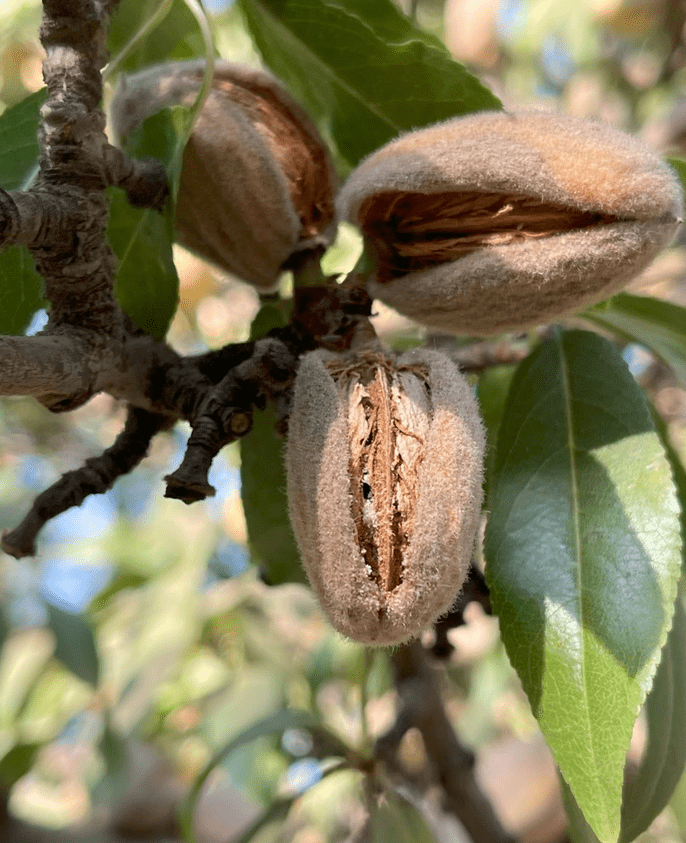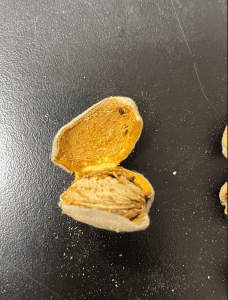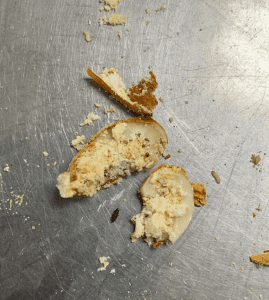
Further incentive to sanitize orchards is here in the shape of a small black beetle.
UCCE and PCAs have been documenting damage to almonds and pistachios by a new invasive pest known as the carpophilus beetle (Nitidulidae: Carpophilus truncatus). Adults deposit their eggs onto new crop nuts, and the larvae that emerge feed on the developing kernels. This species is already well known in Australia, where almond growers have been battling it for the past 10 years. More recently, the carpophilus beetle has also been reported on walnuts in Argentina and Italy.
Carpophilus beetle infestations were first observed in almond and pistachio orchards by Houston Wilson, UCCE entomology specialist (Dept. of Entomology, UC Riverside) based at the Kearney Agricultural Research and Extension Center in Parlier, Calif. Specimens were subsequently confirmed as Carpophilus truncatus by CDFA. Following these initial finds, Wilson partnered with UCCE Kern County farm advisor David Haviland and UCCE IPM advisor Jhalendra Rijal, who is based in northern San Joaquin Valley, to initiate a broader survey of the San Joaquin Valley to determine the extent of these infestations. To date, carpophilus beetles have been confirmed in Stanislaus, Merced, Madera and Kings counties, suggesting this new pest is already quite widespread.
“It’s important that we get on top of this immediately,” Wilson said. “We are already starting to put together a game plan for research and extension in 2024 and beyond.”
Overwinters in Mummy Nuts
Carpophilus beetles overwinter in remnant mummy nuts, and then move onto new crop nuts at hull-split. The adults deposit eggs onto the developing nuts, and the larvae that emerge feed on the kernels. The adults will sometimes also feed on the nut. Damage from carpophilus beetle typically produces a fine powdery mixture of whitish nutmeat and frass, and sometimes an oblong-shaped bore hole can be seen on the nut. Rijal reported almond samples taken recently in Merced and Stanislaus counties showed Carpophilus truncatus damage along with navel orangeworm (NOW) damage inside the same shell.
Wilson said inspecting mummy or new crop nuts may reveal various small black beetles, but they may not all necessarily be Carpophilus truncatus since it is easy to confuse them with other similar-looking beetles. For instance, there are other closely related beetle species in the genus Carpophilus that resemble each other. UC IPM guidelines note that the dried fruit beetles, Carpophilus hemipterus, are the most common species in San Joaquin Valley orchards. Carpophilus mutilatus can also be present in some orchards. Neither of these species will attack tree nuts.
“If you see any small dark beetles that are suspect, reach out to your local farm advisor or County Agricultural Commissioner to get the identification confirmed,” Wilson said.
Given that Carpophilus beetle overwinter in mummy nuts, just like navel orangeworm, both Wilson and Rijal strongly emphasized the need for crop sanitation. “Given the lack of reliable biological and chemical control options for this new pest, crop sanitation is the primary method of control.” Wilson said.
Rijal said that some of the carpophilus beetle specimens confirmed from Merced County were collected in 2022, so it is likely that this beetle has been in the San Joaquin Valley for at least a few years. “Effective sanitation has likely kept numbers low and/or beetle damage was mistakenly attributed to ants, NOW or some other pests,” Rijal said. Lack of mummy sanitation in the majority of orchards last fall and winter due to early and heavy rains likely allowed this pest to build numbers in some regions.
Bob Klein, manager of California Pistachio Research Board, said Australian growers report the beetle is more of a pest in almonds than pistachios. He said pistachio hulls that remain intact are a barrier to beetle infestation. “Like navel orangeworm can’t infest a pistachio nut with an intact hull, it is also a barrier to this beetle,” Klein said.

Need Positive Identification
Much remains to know about this pest, including when it emerges, where the adult beetles move to and how far they can fly. Klein added there are several species of beetles that look alike, and there is a need for positive identification.
“They are small and quick. If you open a nut with an adult beetle inside, they fly off quickly,” Klein said.
Rijal confirmed that if an adult beetle came out when a nut is opened, it is a carpophilus beetle.
“I have seen both larvae and adults of the Carpophilus beetle and navel orangeworm larvae inside the same kernel (i.e., nutmeat) in almonds that we cracked out. Also, out of the several hundred sample nuts we evaluated at the harvest, we found roughly 35% of the nuts were attacked by Carpophilus beetle, 35% by navel orangeworm, and 30% by both. So, it clearly indicated that the Carpophilus beetle does not need navel orangeworm to infest the nuts; they can do direct damage without any help.”
The ability to use insecticides to control carpophilus beetle is unclear. The majority of the beetle’s life cycle is spent protected inside the nut with relatively short windows of opportunity available to attack the adults when they are exposed. The location of the beetles within the nut throughout most of their life cycle also allows them to avoid meaningful levels of biological control.

Without clear chemical or biological control strategies, Wilson stressed the most important tool for managing this beetle is orchard sanitation.
“Given that this pest overwinters on remnant nuts, similar to navel orangeworm, sanitation will be fundamental to controlling it,” Wilson said. “If you need another reason to clean up and destroy mummy nuts, this is it.”
Wilson and Haviland are now working with researchers in Australia to formulate monitoring and management strategies in California. “Over the past 10 years, our colleagues in Australia have generated a lot of good information on the ecology and management of carpophilus beetle, much of which is readily applicable to our conditions in California,” Wilson said.
“For now, crop sanitation is the most important thing growers and PCAs can do to control this new carpophilus beetle.” Wilson said. “We cannot emphasize this enough.”
Wilson said if you suspect that you have this beetle in your orchard, please contact your local UCCE farm advisor (https://ucanr.edu/About/Locations/), County Agricultural Commissioner (https://cacasa.org/county/) and/or the CDFA Pest Hotline (https://www.cdfa.ca.gov/plant/reportapest/) at 1-800-491-1899.










